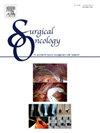可切除胰腺癌磁共振成像表观扩散系数图信号异质性:生物学临界可切除胰腺癌预后的新因素
IF 2.4
4区 医学
Q3 ONCOLOGY
引用次数: 0
摘要
背景:本研究旨在确定可切除胰腺癌(RPC)患者的复发和预后因素,这些因素可能定义生物学边缘性可切除胰腺癌(BRPC)。方法回顾性研究162例R/BRPC患者,均行术前手术。进行单因素和多因素分析,评估术前因素与RPC的无病生存期(DFS)和总生存期(OS)之间的关系。术前磁共振成像表观扩散系数变异系数(CVADC)的截止值采用受试者工作特征曲线分析确定。RPC患者的手术结果通过评分分层,每个独立预后因素分配1分。根据评分比较R/BRPC患者的预后。结果RPC 145例,BRPC 17例。在RPC患者中,血清CA19-9 >;500 U/mL (p = 0.03)和CVADC≥0.1 (p = 0.003)是独立的复发因素,而血清CA19-9 >;500 U/mL (p = 0.03)、肠系膜上静脉/门静脉接触<;180°(p = 0.03)和CVADC≥0.1 (p <;0.001)是独立的预后因素。评分为0分的RPC患者预后明显好于评分为1分或2-3分的患者和BRPC患者(中位DFS: 35.0、9.8、9.0和7.0个月;中位OS分别为80.7、26.5、16.8和17.6个月)。评分为1分或2-3分的BRPC患者与RPC患者预后无显著差异。结论RPC术后CVADC可能是决定生物BRPC复发和预后的新因素。本文章由计算机程序翻译,如有差异,请以英文原文为准。
Signal heterogeneity in apparent diffusion coefficient map of magnetic resonance imaging in resectable pancreatic cancer: a new prognostic factor for biological borderline resectable pancreatic cancer
Background
s: This study aimed to identify recurrence and prognostic factors in patients with resectable pancreatic cancer (RPC) that may define biological borderline resectable pancreatic cancer (BRPC).
Methods
This retrospective study included 162 patients with R/BRPC who underwent upfront surgery. Univariate and multivariate analyses were performed to assess the relationship between preoperative factors and disease-free survival (DFS) and overall survival (OS) for RPC. The cutoff value for the coefficient of variation of apparent diffusion coefficient (CVADC) on preoperative magnetic resonance imaging was determined using receiver operating characteristic curve analysis. Surgical outcomes of patients with RPC were stratified by a score, with each independent prognostic factor assigned 1 point. The outcomes of R/BRPC patients were compared according to the score.
Results
Of the patients, 145 had RPC, and 17 had BRPC. In RPC patients, serum CA19-9 >500 U/mL (p = 0.03) and CVADC ≥ 0.1 (p = 0.003) were independent recurrence factors, while serum CA19-9 >500 U/mL (p = 0.03), superior mesenteric vein/portal vein contact <180° (p = 0.03), and CVADC ≥ 0.1 (p < 0.001) were independent prognostic factors. RPC patients with a score of 0 had significantly better prognoses than those with scores of 1 or 2–3, and BRPC patients (median DFS: 35.0, 9.8, 9.0, and 7.0 months; median OS: 80.7, 26.5, 16.8, and 17.6 months, respectively). No significant difference in prognosis was found between BRPC patients and RPC patients with scores of 1 or 2–3.
Conclusions
Preoperative CVADC in RPC may be a new recurrence and prognostic factor defining biological BRPC.
求助全文
通过发布文献求助,成功后即可免费获取论文全文。
去求助
来源期刊

Surgical Oncology-Oxford
医学-外科
CiteScore
4.50
自引率
0.00%
发文量
169
审稿时长
38 days
期刊介绍:
Surgical Oncology is a peer reviewed journal publishing review articles that contribute to the advancement of knowledge in surgical oncology and related fields of interest. Articles represent a spectrum of current technology in oncology research as well as those concerning clinical trials, surgical technique, methods of investigation and patient evaluation. Surgical Oncology publishes comprehensive Reviews that examine individual topics in considerable detail, in addition to editorials and commentaries which focus on selected papers. The journal also publishes special issues which explore topics of interest to surgical oncologists in great detail - outlining recent advancements and providing readers with the most up to date information.
 求助内容:
求助内容: 应助结果提醒方式:
应助结果提醒方式:


